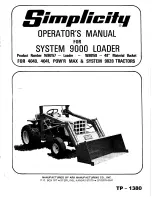
Carefully read personal and machine SAFETY PRECAUTIONS (at the beginning of this manual)
0 - 5
LW170-LW190
SAFETY RULES
In case tests during which the engine should be kept
runinng, a qualified operator must sit in the driver’s seat
with the mechanic in sight at all times. Place the transmis-
sion in neutral, apply and lock the brakes. KEEP HANDS
OFF MOVING PARTS.
In case of field service, move machine to level ground, if
possible, and block it. If work on an incline cannot be
advised, block the machine and its attachments securely.
Move damaged to level ground as soon as possible.
Do not trust worn and/or kinked chains and cables. Never
use them for lifting or pulling. Always wear heavy gloves to
handle chains or cables.
Be sure chains and cables are firmly fastened and that
anchor points are strong enough to withstand the
expected load. Nobody should stay near the anchor
points, cables or chains. DO NOT PULL OR TOW
UNLESS THE OPERATOR’S COMPARTMENTS OF
THE MACHINES INVOLVED ARE FITTED WITH THE
PROPER GUARDS AGAINST BACKLASH IN CASE OF
CABLE OR CHAIN FAILURE OR DETACHMENT.
Keep the area where maintenance is carried out CLEAN
and DRY at all times. Clean immediately all water and oil
spillages.
Do not pile up oily or greasy rags as they represent a major
fire hazard. Always store them in closed metal containers.
Before starting the machine or its attachment, check,
adjust and lock the operator’s seat. Also ensure that
nobody is within the machine operating range. Sound the
horn.
Rust inhibitors are volatile and flammable. Use them only
in well ventilated areas. Keep open flames away - DO NOT
SMOKE - Store containers in a cool well ventilatedplace
where they could not be reached by unauthorised people.
Do not carry loose objects in your pockets that might fall
unnoticed into open compartments.
Wear safety glasses with side shields, hard hat, safety
shoes, heavy gloves when metal particles or similar may
be ejected and hit you.
Wear appropriate protective equipment such as dark
safety glasses, hard hat, protective clothing, special
gloves and footwear while welding. Nearby persons
should also wear dark safety glasses even if they are not
welding. DO NOT LOOK THE WELDING ARC WITHOUT
PROPER EYE PROTECTION.
Become acquainted with all your jacking equipment and its
capacity. Remember that the jacking point on the machine
should be appropriate for the load applied. Also, be sure
the support area of the jack at the machine and on the
ground is appropriate and stable.
Any load supported by a jack represents a possible
hazard. Always transfer the load onto appropriate support
means according to local or national safety requirements
before proceeding with service or maintenance work.
Metal cables get frayed after prolonged use. Always wear
appropriate protections (heavy gloves, goggles, etc.)
while handling them.
Handle all parts carefully. Keep hands and fingers away
from gaps, gears, and similar. Always use and wear the
appropriate protections.
Water can build up in pneumatic systems from
condensate moisture due to changes in atmospheric
conditions. If necessary, drain such deposits following
instructions.
Before carrying out any maintenance work or service, lock
the machine articulated frame modules using the appro-
priate safety device. Remember to remove and store it
properly at the end of work.
If the machine is equipped with hydraulic brakes, make
sure that the reservoir is always filled up to the correct
level.
Always block all wheels, front and rear, before bleeding
the braking system or disconnecting control hoses and/or
cylinders.
STARTING
Do not run the engine in closed buildings without proper
ventilation capable to remove lethal exhaust fumes.
Do not place head, body, limbs, feet, hands or fingers near
rotating fans or belts.
Be especially careful near blower fans.
REMEMBER THAT THE STARTING FLUID IS HIGHLY
FLAMMABLE. Follow recommendations provided in this
Manual and printed on the containers. Containers must be
stored in a cool, well ventilated place out of the reach of
unauthorised persons.
DO NOT PUNCTURE OR BURN CONTAINERS.
ENGINE
Loosen the radiator cap very slowly to relieve system
pressure before removing it. Always top-up coolant level
with the engine off.
Avoid that flammable materials could touch exhaust parts.
If not possible, provide necessary protections.
Do not refuel with the engine running, especially if hot, as
this increases fire hazard.
Never attempt to check or adjust fan belt tensions when
































